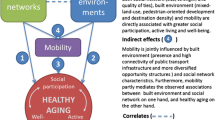Abstract
The increasing interest of the World Health Organization and the European Union towards the concept of disability and active aging has been encouraging research on the problems encountered by people labeled as “weak users” in all kind of contexts. If theaters and parks are not accessible to all, the numbers of visitors and users significantly decrease, since it is not just people with impaired mobility who are forced to give up visiting these resources, but also their family members, friends, or aids. It is clearly important to engage well-aimed actions to guarantee the accessibility and enjoyment of open spaces, both within and outside towns (such as an archaeological park), quickstarting from minimal measures ensuring an immediate response among citizens.
Access this chapter
Tax calculation will be finalised at checkout
Purchases are for personal use only
Similar content being viewed by others
Notes
- 1.
The general purpose of the ICF is to provide a common standard language for the description of the constituents of health issues and the situations they correlate to. Italy is one of the countries that have actively participated in drafting it.
- 2.
On December 3rd, 2001, the Council of the European Union designated 2003 as the European Year of Disabled People, with the objective of: raising citizens’ awareness regarding non-discrimination and integration practices, support concrete actions in favor of equal opportunity and social inclusiveness, informing about good practices at the local, national and European level, intensifying cooperation among all policy actors in favor of people with disabilities, spread a positive image of people with disabilities, and promote the rights of children and young people with disabilities to equal learning opportunities.
- 3.
Adopted by the General Assembly of the United Nations on December 13th, 2006. It was signed for Italy by the Ministry of Social Solidarity on March 30th, 2007 and ratified by Italian Parliament on February 24th, 2009.
- 4.
The European year had as its objective in the raising of public awareness to the contribution the elderly can give to society, improving people’s prospects for aging while remaining active, and encouraging solidarity among generations.
- 5.
Baby Boomer is a term first employed in North America to refer to people born during the 1954–1964 demographic boom.
- 6.
The EDF is a single independent platform in Europe which actively interacts with institutions of the European Union and their political managers. It strives to protect the rights of people with disabilities.
- 7.
ISTAT investigations on health and recourse to health care services, 1999–2000.
- 8.
Constitution of the Italian Republic, art. 3: «All citizens have equal social dignity and are equal in front of the law, with no distinction of sex, language, religion, political opinion, or personal and social condition. It is the task of the Republic to remove all obstacles of economic and social character which, by de facto limiting the freedom and equality of citizens, impede the full development of the human person and effective participation of all workers in the political, economic and social organization of the country».
- 9.
Universal Design is the expression used internationally to designate a modern and far-ranging planning method whose fundamental aim is to plan and create buildings, products and environments that are accessible to all categories of people, with or without disabilities.
- 10.
The term RFId (Radio Frequency Identification) designates a set of systems to identify objects automatically, used to assist people with disabilities. It was adopted in the regional natural park of the Julian Prealps.
- 11.
Linee guida per il superamento delle barriere architettoniche nei luoghi d’interesse culturale, Chap. 2.3.7 [Guidelines for the overcoming of architectural barriers in places of cultural interest, Ministry of Cultural Heritage].
References
F. Vescovo, La disabilità smentita: i percorsi nell’arte, nel pensiero e nella natura, in Atti del Convegno transnazionale 25 giugno 1998. Supplemento a “Sociologia” 1 (Gangemi Editore, Roma, 2000)
F. Vescovo, Obiettivo: progettare un ambiente urbano accessibile per un’utenza ampliata. Paesaggio Urbano 1 (2002). Maggioli Editore, Rimini
Author information
Authors and Affiliations
Corresponding author
Editor information
Editors and Affiliations
Rights and permissions
Copyright information
© 2020 Springer Nature Switzerland AG
About this chapter
Cite this chapter
Casiddu, N. (2020). Moving Through. The Issue of Accessibility and Archaeological Sites. In: Marchetti, N., Franco, G., Musso, S., Spadolini, M. (eds) An Integrated Approach for an Archaeological and Environmental Park in South-Eastern Turkey. Springer, Cham. https://doi.org/10.1007/978-3-030-32754-5_9
Download citation
DOI: https://doi.org/10.1007/978-3-030-32754-5_9
Published:
Publisher Name: Springer, Cham
Print ISBN: 978-3-030-32753-8
Online ISBN: 978-3-030-32754-5
eBook Packages: Literature, Cultural and Media StudiesLiterature, Cultural and Media Studies (R0)




